#Free Online Project Management Tool
Explore tagged Tumblr posts
Text
Management Tools

In today's fast-paced business environment, leveraging the right management tools is crucial for efficiency, productivity, and success. This article delves into key tools that facilitate better management practices. From client management to task management, and not forgetting team management, we're about to unpack the essentials that keep the modern business ticking like a well-oiled machine. Imagine trying to juggle a dozen balls in the air; without the right tools, you're bound to drop one. That's where these tools come into play, ensuring that nothing falls through the cracks.
When it comes to Client Management Tools, think of them as your digital Rolodex but with superpowers. They streamline interactions and improve relationships with customers by organizing information, tracking communication, and managing sales pipelines effectively. It's like having a personal assistant who knows everything about your clients and can remind you of their preferences, purchase history, and even predict their future needs.
Task Management Tool, on the other hand, are the backbone of project management. They help teams stay organized and focused by allowing for the assignment of tasks, setting deadlines, and monitoring progress. It ensures projects stay on track, and deadlines are met with a precision that would make a Swiss watchmaker nod in approval. Imagine a world where missed deadlines are as rare as a unicorn sighting; that's the power of effective task management.
Last but not least, Team Management Tools are the glue that holds everything together. They enhance collaboration and communication within teams, offering features like messaging, file sharing, and progress tracking. These tools optimize workflows and boost productivity by ensuring everyone is on the same page, literally and figuratively. It's like having a virtual meeting room where ideas flow freely, and progress is made visible to all.
In conclusion, the explosion of digital tools has brought about a surprise element in how efficiently businesses can be managed today. The right tools not only simplify management tasks but also propel businesses towards achieving their goals with unprecedented speed and efficiency. As we continue to navigate the complexities of the modern business landscape, these tools will undoubtedly play a pivotal role in shaping the future of business management. So, are you ready to embrace these changes and take your business to new heights?
Client Management Tool
In the whirlwind of modern business, where every interaction counts and every customer is gold, a becomes the superhero cape every company needs. Imagine a world where all your client information is not just a jumbled mess in a drawer but organized neatly, accessible with the click of a button. That's the power of client management tool. They don't just store information; they turn it into a goldmine of opportunities. By tracking communication, managing sales pipelines, and organizing client data, these tools ensure that no lead is lost and every client feels like they're the only one.
But what sets a great client management tool apart? Let's take Prodeskly, for example. It's like having a personal assistant for each client, one that never sleeps. Prodeskly streamlines interactions, ensuring that you're always a step ahead. Whether it's following up on a lead, scheduling meetings, or sending out personalized communications, Prodeskly handles it with finesse. It's like having the Midas touch; every interaction is turned into an opportunity for growth.
Moreover, the integration capabilities of such tools are nothing short of magical. They can seamlessly connect with your existing systems, be it your email, calendar, or even social media platforms. This ensures a smooth workflow and that no piece of information is ever lost in translation. The result? A stronger relationship with your customers, built on the foundation of trust and efficiency.
In conclusion, in the bustling marketplace of today, a client management tool is not just an option; it's a necessity. It's the difference between surviving and thriving. And with tools like Prodeskly, you're not just managing your clients; you're delighting them, one interaction at a time. So, if you're looking to explode your business's efficiency and surprise your clients with unparalleled service, diving into the world of client management tools is the first step towards that goal.
Task Management Tool
In the whirlwind of modern business, a emerges as a beacon of order. Imagine the scenario: deadlines looming, projects piling up, and the team's focus scattered. This is where a task management tool, like Prodeskly, steps in to turn chaos into clarity. It's not just about listing what needs to be done; it's about creating a roadmap for success.
With Prodeskly, assigning tasks becomes a breeze. You can delegate responsibilities based on team members' strengths and availability, ensuring that no one is overwhelmed. But it's not just about doling out assignments. Setting deadlines is equally crucial, and Prodeskly allows you to do this with precision, ensuring everyone is on the same page and projects stay on track.
Monitoring progress is another key feature. Imagine being able to see, at a glance, how each project is advancing. This transparency helps in identifying bottlenecks early and adjusting strategies accordingly. It's like having a bird's-eye view of your entire operation, with the ability to zoom in on details as needed.
But why stop at task assignment and progress tracking? Prodeskly takes it a step further by fostering collaboration. Team members can share files, discuss ideas, and provide updates all within the platform. This not only streamlines communication but also ensures that everyone is working towards the same goal.
In conclusion, a task management tool like Prodeskly is not just a nice-to-have; it's a must-have for modern businesses aiming for efficiency and productivity. By organizing tasks, setting clear deadlines, and enhancing team collaboration, Prodeskly propels businesses towards their goals, making the journey from chaos to clarity not just possible, but also enjoyable.
Team Management Tool
In the whirlwind of today's professional landscape, the introduction of a can feel like a sudden explosion of clarity amidst chaos. Imagine a scenario where every member of your team is rowing in unison, synchronized to the rhythm of productivity and efficiency. That's the promise of modern team management tool. They are not just software; they are the digital embodiment of synergy and collaboration.
With features designed to enhance communication, streamline project management, and foster a culture of transparency, these tools are the secret sauce to a well-oiled machine. Imagine being able to track the progress of projects in real-time, share files without a hitch, and send messages that don't get lost in the abyss of overflowing inboxes. It's like having a superpower that enables your team to transcend geographical and temporal barriers, ensuring that everyone is on the same page, literally and figuratively.
But what sets a great team management tool apart? It's the ability to customize it to fit the unique needs of your team. Whether you're a startup on the brink of discovery or a seasoned enterprise navigating the complexities of scale, there's a tool tailored just for you. From kanban boards to Gantt charts, these tools offer a variety of ways to visualize workflows and optimize productivity.
However, it's not just about the features. The real magic lies in the tool's capacity to foster a culture of accountability and empowerment. By providing a platform where contributions are visible and recognized, team members are motivated to bring their best selves to the table every day. It's a win-win situation where the tool not only propels the project forward but also fuels personal growth and satisfaction among team members.
In conclusion, embracing a team management tool is akin to unlocking a new level of potential within your team. It's about making the leap from working hard to working smart, where surprise and explosion in productivity become the norm. So, dive in, explore the options, and prepare to be amazed at how much more your team can achieve when they're empowered with the right tools.
#Free Online Project Management Tool#Cloud-Based Project Management#Collaborative Project Planning Software#Task Management Tool#Client Management Tool#Team Management Tool
2 notes
·
View notes
Text
#Free Online Project Management Tool#Cloud-Based Project Management#Collaborative Project Planning Software#Task Management Tool#Client Management Tool#Team Management Tool
1 note
·
View note
Text
Key Factors That Influence the Accuracy of a Construction Cost Estimating Service
In the world of construction, accurate cost estimation is the cornerstone of a successful project. A well-prepared cost estimate ensures that all financial resources are allocated appropriately, preventing overruns and ensuring that the project is completed on time and within budget. Construction cost estimating services play an essential role in creating these accurate estimates, but several factors influence their precision. From the complexity of the project to the quality of data used, understanding these factors is key to achieving reliable estimates.
1. Quality and Accuracy of Data
The foundation of any cost estimate lies in the quality of the data used. Construction cost estimating services rely on a vast array of data points, including material costs, labor rates, equipment rental fees, and historical cost data from similar projects. Accurate and up-to-date information ensures that the estimate reflects current market conditions and the specific needs of the project. Outdated or unreliable data can lead to significant discrepancies, resulting in either underestimation or overestimation of costs. The use of industry-specific cost databases and local market data helps ensure the accuracy of these figures.
2. Project Scope and Complexity
The scope and complexity of a construction project directly influence the accuracy of a cost estimate. Larger, more intricate projects—such as skyscrapers or complex infrastructure developments—require detailed and nuanced cost breakdowns. These projects involve multiple phases, specialized materials, and skilled labor, making them harder to estimate accurately without in-depth knowledge and analysis. On the other hand, smaller, simpler projects are easier to estimate but still require attention to detail. A construction cost estimating service will typically consider all aspects of the project, including site preparation, design elements, and unforeseen challenges, which can affect the final cost.
3. Labor and Material Costs
Labor and material costs are two of the most significant components of any construction project, and fluctuations in these costs can dramatically influence the accuracy of a construction cost estimate. Construction cost estimating services need to account for the specific labor rates in the project’s geographic location, as well as the availability and prices of materials. Regional differences in labor costs, transportation fees for materials, and even seasonal variations can impact the overall budget. For example, labor shortages or sudden increases in the price of steel can lead to cost overruns if not properly anticipated in the estimate.
4. Project Timeline
The duration of a project is another critical factor that affects cost estimates. A longer timeline may lead to increased labor and material costs, especially in projects where inflation or market shifts are a concern. Construction cost estimating services must factor in not only the initial costs but also the potential impact of delays, extended timelines, or changes in the project scope. Delays, whether due to weather, supply chain issues, or labor disputes, can significantly alter the estimated costs if they are not properly accounted for from the beginning.
5. Site Conditions and Location
Site conditions and location play an essential role in determining construction costs. The geographical location of a project can influence everything from the cost of labor and materials to the difficulty of site preparation. For example, projects located in urban areas may face higher labor costs and limited space for staging, while rural sites may have access to more affordable labor but may require longer transportation times for materials. Environmental factors such as soil quality, weather conditions, and terrain also influence costs, as they can affect the type of construction methods, equipment, and materials required.
6. Use of Advanced Technology
In recent years, advancements in technology have greatly improved the accuracy of construction cost estimates. Modern construction cost estimating services often incorporate Building Information Modeling (BIM), advanced software tools, and automated takeoff systems to provide more precise and efficient estimates. These technologies help estimators create detailed 3D models of the project, allowing them to calculate quantities, materials, and labor requirements with a high level of precision. Additionally, the integration of real-time data and predictive analytics allows for more accurate forecasting, especially for large, complex projects.
7. Historical Data and Experience
Experience and historical data play a pivotal role in determining the accuracy of construction cost estimating services. Estimators with a deep understanding of past projects, including their successes and challenges, can provide more reliable cost estimates. For example, knowing the typical costs associated with a particular type of building or construction method can serve as a benchmark for new projects. Having access to historical data also allows estimators to identify trends and adjust for factors that may not be immediately obvious, such as fluctuating demand for certain materials.
8. Contingency Planning
Contingencies are a crucial aspect of construction cost estimating. Unexpected issues, such as changes in project scope, unanticipated site conditions, or regulatory changes, can quickly alter a project’s budget. A well-prepared construction cost estimating service will always include a contingency allowance in the estimate to account for these uncertainties. The size of the contingency will depend on the complexity of the project, the risks involved, and the level of uncertainty surrounding the project’s scope and timeline. Proper contingency planning ensures that the project stays on track financially, even when unexpected challenges arise.
9. Regulatory and Permitting Requirements
Each construction project must comply with local regulations and permitting requirements. These rules can significantly impact the final cost estimate. For example, if a project requires specialized permits or adherence to strict environmental standards, the cost of compliance may add considerable expenses. Construction cost estimating services must stay up-to-date with the latest regulations and requirements to ensure that they include these costs in the estimate.
10. Collaboration and Communication
Effective collaboration and communication between all project stakeholders are essential for accurate cost estimation. A construction cost estimating service must work closely with architects, engineers, contractors, and clients to ensure that all aspects of the project are considered. Misunderstandings or lack of communication can lead to missed costs or unrealistic estimates. Clear communication helps all parties align on project goals, scope, and budget, ensuring that the estimate reflects the true financial needs of the project.
Conclusion
The accuracy of a construction cost estimating service is influenced by a variety of factors, ranging from data quality and project complexity to technology and site conditions. By understanding these key influences, construction professionals can improve the precision of their cost estimates and avoid costly mistakes during the project. A comprehensive approach that incorporates detailed data, advanced tools, and effective collaboration ensures that estimates remain as accurate as possible, providing a solid foundation for successful project execution.
#Best Construction Cost Estimating Service#Affordable Construction Cost Estimating Service#Professional Construction Cost Estimating Service#Reliable Construction Cost Estimating Service#Construction Cost Estimating Service for Contractors#Top Construction Cost Estimating Service Providers#Construction Cost Estimating Service for Residential Projects#Construction Cost Estimating Service for Commercial Projects#Accurate Construction Cost Estimating Service#Construction Cost Estimating Service for Large Projects#Expert Construction Cost Estimating Service#Construction Cost Estimating Service with Detailed Reports#Construction Cost Estimating Service for Remodeling#Construction Cost Estimating Service for New Builds#Comprehensive Construction Cost Estimating Service#Online Construction Cost Estimating Service#Free Construction Cost Estimating Service Tools#Construction Cost Estimating Service for Architects#Fast Construction Cost Estimating Service#Construction Cost Estimating Service for Developers#Construction Cost Estimating Service Software#Construction Cost Estimating Service for Small Projects#Construction Cost Estimating Service for Homeowners#Accurate Online Construction Cost Estimating Service#Affordable Construction Cost Estimating Service Near Me#Construction Cost Estimating Service for Budgeting#Why Choose a Construction Cost Estimating Service#Construction Cost Estimating Service for Project Management#Local Construction Cost Estimating Service Experts#Customized Construction Cost Estimating Service Solutions
0 notes
Text
Top Tools and Services That Improve Productivity in the Workplace
In today’s fast-paced business environment, enhancing workplace productivity is paramount for sustained growth and success. Employers and team leaders are on a constant lookout for tools and services that can streamline operations and facilitate better project management. From cloud-based platforms to automated software, there are myriad options available that cater to various business needs. In…

View On WordPress
#automation software#communication tools#document sharing services#free online cloud storage#productivity in the workplace#project management platforms#time tracking management tools
0 notes
Text
Online CRM Project Management Tools - CRM Software App
Explore top-notch Online CRM Project Management Tools on CRM Software App. Streamline your project workflows, enhance collaboration, and boost productivity with our comprehensive CRM software suite. Elevate your project management game today
#Online CRM Project Management Tools#crm ipad app#invoice template#small business crm#schedule an appointment#free invoice generator#crm software app
0 notes
Text
Beauty AND brains. Your knowledge is your weapon.
Let's not only be insanely beautiful but also disgustingly educated. Other than discipline and hard work, your knowledge is your weapon in this world of chaos, something that you can sharpen and use.
Where can you expand your knowledge? What areas, what topics
How can you expand your knowledge? In different circumstances and preferences such as if you're too busy or if you have a short attention span

Where can you expand your knowledge?
I DO NOT mean that you need to be an expert at everything. You don't need multiple degrees for each type of intelligence. However, if you want to sharpen your weapon, sharpen your knowledge.
These are the areas where you CAN sharpen your knowledge AND the areas where you SHOULD know the basics in:
Emotional, Communication, Morals, Ethics. Be human, and make others feel human too. Cultivate empathy, understand mental health, build your conscience, and differentiate right from wrong. Communicate frequently and effectively.
History, Culture, Politics. The world is chaotic — learn to stand your ground. Understand history, politics, corruption, culture, and the overlooked heroes. Know what shaped the past to navigate the future.
Digital Literacy. The internet is a double-edged sword. Learn to navigate it safely, protect your privacy, spot misinformation, and adapt to evolving technology.
Manners, Etiquette, Body Language. The way you present yourself matters. Respect others, read unspoken cues, and master the art of presence.
Self-Sufficiency, Life Skills, Livelihood. You won’t always have someone to rely on. Cook, clean, manage time, handle money, and adapt to life’s challenges. Be independent.
Literature, Language, Writing. Words are power. Read, write, and communicate with depth. Language shapes history, culture, and thought—use it wisely.
Critical Thinking, Problem-Solving. The world isn’t black and white. Question everything, analyze critically, recognize manipulation, and think for yourself. Don't be swayed easily by others.
Science and Math. The foundation of everything. At least know the basics, enough to understand the forces shaping the world — logic, numbers, and the universe itself.
Self-Care, Hygiene, Fitness, Health. Your body and mind are your greatest assets. Eat well, stay active, manage stress, and prioritize your well-being before it’s too late.

How can you expand your knowledge?
When you have free time When you're busy When you prefer learning visually When you have little to no attention span
You are what you consume. Now that you know what topics you can expand your knowledge on, these are what you can use / do to consume those information:
Have some free time? Do / use these
Read books, take online courses, or watch in-depth documentaries. (Example: history books, finance courses, science explainers) Engage in discussions or debates to refine your thinking. (Example: politics, ethics, critical thinking) Try hands-on learning like experiments, DIY projects, or journaling. (Example: cooking, coding, writing) Attend workshops, seminars, or community events.
Too busy? Do / use these
Listen to podcasts or audiobooks while traveling, doing tasks / work / school work, or doing chores. (Example: podcasts on Spotify / Tiktok, Youtube videos where the creator is more on speaking, audiobooks on Audible or by downloading a free e-pub format e-book online then uploading it into Google Playbooks and using the audiobook / text-to-speech format) Follow bite-sized content on social media. (Example: short educational / history Tiktok videos, digital literacy infographics, photos on Pinterest) Take advantage of apps and tools for productivity, learning, etc. (Example: budgeting apps, language-learning apps) Watch short, informative videos during breaks. (Example: TED-Ed, Ted Talks, short Tiktok videos)
Like to learn visually / by watching? Do / use these
Watch video explainers, documentaries, or animated infographics. Use apps that gamify learning. (Example: Duolingo for language, Codecademy for coding) Follow visually engaging content creators. (Example: finance charts, body language breakdowns) Make mind maps or illustrated notes to break down complex topics. (Example: self-care routines, political structures, problem-solving techniques)
Little to no attention span? Do / use these
Learn through short-form content like TikToks, reels, or infographics. Play interactive or gamified learning apps. (Example: strategy games, trivia quizzes) Follow meme-based or storytelling-style education accounts. Try hands-on, fast-paced activities. (Example: debate flash rounds, real-world problem-solving challenges, DIY experiments)

Begin small, learn the basics, take a step at a time, and start from there. Be BOTH beauty and brains. You have a weapon (your knowledge), sharpen it and use it.
#strawberrysznn#strawberry#self love#mental health#mindset#mental growth#it girl#growth#glow up#girlblogging#self growth#self improvement#this is a girlblog#self help#advice#self care#selfhelp#reminder#life advice#self reminder#it girl energy#becoming that girl#girlboss#girlblog#self development#pink pilates princess#clean girl#health and wellness#glow up tips#dream girl
1K notes
·
View notes
Text
Tech how-to article written like a recipe. Is that anything? Fuck it.
Old-Fashioned Setting Up a Password Manager
For this project you will need:
One computer
One full-featured browser
One pre-made email account, not shared and logged-in
2-5 possible passwords
5-10 accounts to get started with storing passwords.
Before you begin pre-load your computer, logging in to your email account. You can save later prep time by having your primary social media accounts, banking information, email account, and online bills ready to hand.
Go to bitwarden.com and select "create account"; be sure to select "free account" - you can jazz it up later but we're learning the basics now.
Create the account using your primary email address as the login name and one long (but not complicated!) password that you are certain you can remember but is not widely shared online. This is a great way to use information about your favorite movies or songs, not a great place for your kid's or pet's names.
Set up your password hint with a good reminder; be sure to note any punctuation you added, for instance a comma to separate lines of a song or an exclamation point between words of a movie title.
Verify your email account with the password manager, then set up a new password for your email. You may need a phone or access to your extant 2FA tools for this step. Create a login in the password manager, add your email address, and generate a new password, then save the entry. Go to your email account, select "security" and "change password" - enter your old password to confirm then paste your new password manager generated password into the provided text boxes, and save. Log out of your email account, then log back in with your new password. You will need to do this on all of your devices, so make sure you're using a password manager that is accessible across platforms - Bitwarden is recommended for a reason, this is a place where you don't want to skimp when making substitutions!
Repeat the process of resetting passwords to taste; you don't need to do everything all at once, but it's best to start with a serving of 5-8 to get used to the process.
Time: 30min to 2hr DOE Expense: Literally Free Value: Priceless i never have to remember a fucking password again and now neither do you.
5K notes
·
View notes
Text
Unlocking the Magic of Ravelry: A Guide to the Biggest Online Fiber Arts Community
If you're a knitter, crocheter, spinner, or fiber arts enthusiast, chances are you've heard whispers of a place called Ravelry. For those new to the scene or just dipping their toes into the yarn-filled waters, Ravelry is more than just a website—it's a treasure trove of inspiration, organization, and community. Here’s what you need to know to get started and make the most of this fiber-lover’s paradise.
Whether you’re a beginner looking for your first scarf pattern or a seasoned designer managing dozens of published works, Ravelry is an incredible tool. It helps you organize your craft, discover new ideas, and join a global community that understands the thrill of finishing that last sleeve or unraveling an entire sweater (we’ve all been there).
What is Ravelry?
Ravelry is a free social networking site and database designed specifically for fiber artists. Launched in 2007, it quickly became the go-to platform for tracking projects, discovering patterns, and connecting with fellow crafters from around the world. Think of it as a combination of Pinterest, Goodreads, and a really helpful knitting circle—all wrapped up in one cozy interface.
Let's Get Started
1. Create a Free Account Visit www.ravelry.com and sign up. You’ll just need a username, email, and password. Once you're in, you’ll have access to thousands of free and paid patterns, forums, yarn databases, and tools. Please add me as a friend once you've created you're account! I'd love to see what all of you are up to!
Once your account is set up, you can take this time to set up your profile. Mind is linked with a couple of projects I'm working on, my blog, and I'm currently working on building out my yarn stash database.
Explore Patterns
One of Ravelry’s biggest draws is its massive pattern library. You can search by:
Craft (knitting, crochet, weaving, etc.)
Yarn weight
Project type (socks, sweaters, shawls, etc.)
Free vs. paid
Difficulty level
Each pattern includes notes from the designer, photos, and—best of all—user-submitted projects so you can see how the pattern works up in different yarns or sizes. Ravelry has a really great set of filters, so I suggest playing around with it and seeing what works best for you!
Log Your Projects
Want to remember what size needles you used for that hat last winter? Or which yarn didn’t work out so well? The “Projects” tab lets you document every detail:
Pattern used
Yarn and yardage
Hook or needle size
Notes and modifications
Progress photos
This not only helps you stay organized, but also contributes to the collective wisdom of the Ravelry community.
Stash and Library Features
Stash – Catalog all the yarn you own. This can help when you’re out shopping and wondering, “Do I already have something like this at home?”
Library – Keep track of all the patterns you’ve downloaded or favorited. It’s especially useful for managing PDF files and ensuring you don’t accidentally buy the same pattern twice.
Connect with the Community
Ravelry is also home to thousands of groups based on location, interests, fandoms, yarn brands, designers, and more. You can ask for advice, join knit-alongs, or just chat with fellow fiber nerds.
The forums are active and full of helpful threads on techniques, troubleshooting, and yarn recommendations.
Marketplace and Indie Designers
Ravelry supports thousands of indie designers who sell their patterns directly through the site. You can often message designers with questions, follow your favorites, and even leave tips. Supporting small creators has never been so seamless.
So grab your yarn, your needles, and a cup of tea—Ravelry is waiting.
Have you used Ravelry before? What’s your favorite feature? Drop a comment or share your profile—I’d love to follow your fiber adventures!
#knitting#yarn#creative#pattern#crafts#ravelry#love#knits#hand knitted#knit#knitblr#knitters of tumblr#knitting pattern#knitwear#colorwork#scarf#blanket#handmade#diy projects#diy craft#diy#yarn crafts#yarnblr#yarnaby#crochet yarn#fiber crafts#crocheting#crochet#online#business
94 notes
·
View notes
Text
Kickstart Your Earnings with Content Writing: A Beginner’s Friendly Roadmap
If you’ve ever wondered how ordinary people turn their words into cash, content writing might be your sweet spot. You don’t need a fancy degree or decades of experience to get started. With some guidance, dedication, and a dash of creativity, you can start earning from content writing sooner than you think. This guide walks you through each step in a friendly, down‑to‑earth way so you’ll feel confident launching your freelance writing journey.

Why Content Writing Is a Great Starting Point Content writing covers everything from blog posts and web pages to social media captions and product descriptions. Businesses of all sizes need fresh, engaging words to connect with their audience, rank higher in search engines, and boost sales. As companies continue to invest in digital marketing, demand for quality content writers stays strong. Plus, you can work from anywhere, set your own hours, and choose projects that spark your interest.
Understanding the Basics of Earning from Content Writing At its core, earning from content writing means providing value through written words. Clients pay for:
Research that saves them time
SEO‑friendly copy that boosts visibility
Clear, engaging storytelling that connects with readers
Consistent output that maintains an active online presence
Your job is to become the go‑to person who delivers those benefits reliably.
Step 1: Identify Your Niche and Strengths While generalists can find work, specializing helps you stand out. Consider topics you enjoy or know well—travel, personal finance, health and wellness, tech, lifestyle, parenting, gaming, or education. Having a niche makes it easier to showcase your expertise and justify higher rates. If you’re a fitness buff who loves writing, focus on blogs and articles in that sphere. If you have a background in software, aim for tech how‑to guides.
Step 2: Build a Portfolio That Shows Your Skills Clients want proof you can write well. Even if you haven’t been paid yet, you can create sample pieces:
Start a personal blog or Medium page and publish 3 to 5 high‑quality articles in your niche.
Guest post on small blogs that accept submissions.
Rewrite or summarize existing news stories in your voice (clearly marked as samples).
Draft mock project pieces for imaginary clients—product descriptions, newsletters, or landing pages.
Organize these in a simple online portfolio. You can use free tools like Google Sites, Wix, or WordPress. Make sure each sample highlights your SEO skills by including relevant keywords naturally in titles and subheadings.
Step 3: Optimize Your Online Profiles for Visibility Next, set up profiles on freelance platforms and job boards. Popular destinations include Upwork, Fiverr, Freelancer, ProBlogger, Contena, and LinkedIn. When crafting your profile:
Write an engaging headline that includes “content writer” or “freelance writer.”
Summarize your background, niche focus, and any standout achievements.
List your portfolio samples or link directly to your site.
Add relevant skills: SEO, WordPress, SEMrush, Mailchimp, social media management, etc.
Request testimonials from friends or colleagues who can vouch for your work ethic or writing ability.
A well‑optimized profile boosts your chances of appearing in client searches and winning invitations.
Step 4: Find Your First Paid Gigs Landing that first paid project often takes persistence. Strategies that work:
Pitch directly to small businesses or local startups. Send personalized emails offering a free trial article or website audit.
Apply to relevant listings daily on freelance boards. Tailor each proposal to the client’s needs—mention specifics from their job post.
Explore niche‑specific boards like BloggingPro or JournalismJobs for targeted opportunities.
Network on LinkedIn by sharing helpful writing tips, engaging with posts in your niche, and connecting with marketing professionals.
Early on, you might accept lower‑priced gigs to build credibility, but avoid underpricing yourself. Aim for a rate you can increase once you’ve racked up 5 to 10 positive reviews.
Step 5: Master SEO and Content Strategy SEO savvy writers command better fees. Search Engine Optimization involves understanding how keywords, user intent, and readability affect rankings. To shine:
Use free keyword research tools like Google Keyword Planner or Ubersuggest to identify target phrases.
Incorporate primary keywords in titles, opening paragraphs, subheadings, and naturally throughout the text.
Keep sentences concise, break up text with subheadings, and add bullet lists or numbered steps for scannability.
Learn basic on‑page SEO: meta descriptions, internal linking, image alt text, and proper URL structure.
Businesses pay for measurable results. If your copy ranks higher and drives traffic, you become more valuable.
Step 6: Set Competitive Rates and Payment Terms Knowing how much to charge can feel tricky. Common approaches include:
Per‑word rate: New freelance writers often start at five to ten cents per word, moving up to twenty cents or more with experience.
Per‑hour rate: Beginners might charge twenty to thirty dollars per hour, progressing to fifty and beyond as skills sharpen.
Per‑project fee: Flat rates for complete blog posts or web pages, factoring in research, revisions, and strategy.
Always agree on payment milestones. A 50/50 split works—half up front, half on completion. Use contracts to outline deliverables, deadlines, and revision policies. This keeps both sides on the same page.
Step 7: Deliver Quality and Build Long‑Term Relationships Repeat clients are freelancing gold. To keep clients coming back:
Meet deadlines without reminders.
Communicate clearly—let them know if you hit a roadblock and propose solutions.
Offer a revision round to refine the piece to their liking.
Suggest topic ideas for future posts based on emerging trends in their industry.
When clients see you consistently add value, they’ll hire you again and refer you to others.
Step 8: Leverage Tools and Continuous Learning Stay competitive by embracing helpful platforms:
Grammarly or ProWritingAid to polish grammar and tone.
Yoast or Rank Math (for WordPress) to fine‑tune on‑page SEO.
Trello or Asana for managing multiple projects smoothly.
Google Analytics basics to understand content performance.
Invest time in online courses or webinars on SEO, storytelling, and copywriting. The more you learn, the more you can charge.
Step 9: Scale Your Earnings Over Time Once you’ve established a steady stream of projects, scaling becomes the name of the game. Options include:
Raising your rates for new clients while maintaining current engagements.
Packaging content services—offer blog writing plus email newsletters or social media management as a bundle.
Outsourcing parts of the work, like research or editing, to junior writers, allowing you to focus on strategy and client relations.
Creating digital products, such as eBooks or courses on content writing, to earn passive income.
Diversifying revenue streams helps insulate your income from slow periods.
Putting It All Together Earning from content writing is an achievable goal, even if you’re starting from scratch. By identifying your niche, building an impressive portfolio, mastering SEO, and delivering top‑notch work, you’ll attract clients eager to pay for your expertise. Remember that patience and persistence pay off. Treat every project as a chance to improve your craft and delight a client. Before you know it, you’ll have a thriving freelance writing business that fits your lifestyle and fuels your creative passions.
10 notes
·
View notes
Text
The Top 10 Hardest Things About Starting a Small Business (And How to Overcome Them)
Starting a small business is an exciting journey, but it is not all passion projects and overnight success. Whether you’re launching a sticker business, an online store, or a local shop, the process is filled with challenges, setbacks, and lessons you never saw coming.
From funding struggles to burnout, many entrepreneurs face unexpected obstacles that can make or break their business. But knowing what to expect—and how to overcome these hurdles—can help turn challenges into opportunities.
Here are the ten hardest things about starting a small business and how to tackle them successfully.
1. Finding the Right Business Idea
The Challenge:
You might have too many ideas, or you may not be able to think of a single good one. Choosing the right business idea is tough because:
• It needs to be profitable.
• It should align with your skills and passion.
• It has to have market demand, meaning people actually want to buy it.
How to Overcome It:
• Test your idea before going all in—survey potential customers or create a prototype.
• Research the competition—if no one is doing it, there may be a reason such as lack of demand.
• Solve a problem—successful businesses fill a gap in the market.
Your first business idea does not have to be your last. Many entrepreneurs pivot after learning what works.
2. Getting Funding for Your Business
The Challenge:
Most businesses need money to start, but where do you get it? Banks require strong credit, investors want proof of success, and using your own savings is risky.
How to Overcome It:
• Start small and test with low-cost products before expanding.
• Look for alternative funding such as crowdfunding, grants, or small business loans.
• Consider bootstrapping by reinvesting early profits instead of taking on debt.
Pre-selling your products is a smart way to generate cash flow before investing too much.
3. Learning Everything (Marketing, Sales, Accounting, and More)
The Challenge:
As a business owner, you wear all the hats—you are the marketer, accountant, customer service rep, and CEO all at once.
How to Overcome It:
• Learn the basics with free online courses on marketing, finance, and branding.
• Use business tools such as accounting software, AI for content creation, and social media planners.
• Outsource when possible by hiring freelancers for things you do not have time to master.
Focus on your strengths and outsource the rest once you can afford it.
4. Building a Customer Base from Scratch
The Challenge:
No customers means no sales. But how do you get people to trust a brand that just launched?
How to Overcome It:
• Leverage social media by consistently posting valuable content.
• Offer early discounts or freebies to incentivize first-time buyers.
• Encourage word-of-mouth by asking happy customers for reviews.
Building a strong brand identity, including a logo, website, and social proof, makes people more likely to buy from you.
5. Managing Time and Avoiding Burnout
The Challenge:
Most small business owners work much more than 40 hours a week—without a boss to set limits, it is easy to burn out.
How to Overcome It:
• Set a schedule and balance work time with personal time.
• Prioritize tasks by focusing on what moves the business forward.
• Take breaks because burnout leads to bad decisions and lower productivity.
You are more productive when well-rested. Take at least one day off per week to recharge.
6. Handling Self-Doubt and Fear of Failure
The Challenge:
Every entrepreneur asks themselves, “What if this fails?” Self-doubt can kill motivation before you even start.
How to Overcome It:
• Focus on progress, not perfection—you will learn as you go.
• Surround yourself with support by connecting with other business owners.
• Celebrate small wins—every sale is proof that you are on the right track.
Every successful business owner has failed before. The key is learning and pivoting when needed.
7. Dealing with Slow Sales and Unpredictable Income
The Challenge:
Some months are great, while others are painfully slow—especially in the beginning.
How to Overcome It:
• Have a backup fund by setting aside money during good months.
• Create multiple revenue streams by selling online, at markets, and on different platforms.
• Run promotions during slow periods, such as flash sales or limited-time discounts.
Focus on repeat customers because loyal customers spend more and shop often.
8. Standing Out in a Crowded Market
The Challenge:
No matter what business you start, there is competition. So how do you make people choose you over others?
How to Overcome It:
• Find your Unique Selling Proposition (USP)—what makes your brand different?
• Offer top-tier customer service because people remember great experiences.
• Build a personal brand so that people connect with you, not just your product.
Brand story matters—people buy from businesses they relate to.
9. Managing Inventory and Supply Chain Issues
The Challenge:
Whether you are selling physical products or digital goods, inventory management can be a headache—especially when suppliers have delays or price increases.
How to Overcome It:
• Start with small batches and do not overstock before testing demand.
• Work with reliable suppliers and always have a backup plan.
• Track inventory closely using software to avoid running out or over-ordering.
Having a pre-order system can help manage unexpected inventory shortages.
10. Staying Motivated When Things Get Hard
The Challenge:
Not every day will be exciting. Some days, you will want to quit. Motivation comes and goes, but consistency is key.
How to Overcome It:
• Remember your “why”—what made you start this business?
• Join entrepreneur communities because talking to other business owners helps.
• Set small goals by breaking big tasks into manageable wins.
Mindset is everything—keep pushing forward, even when it is tough.
Final Thoughts: Is Starting a Small Business Worth It?
Absolutely. Even though starting a business is hard, the freedom, creativity, and potential for success make it worth the effort. Every challenge you face is a learning opportunity that brings you closer to long-term success.
What is the hardest part of starting a business for you? Share your thoughts in the comments.
Looking for custom stickers for your small business? Check out BeaStickers.ca for high-quality, waterproof branding solutions.




7 notes
·
View notes
Text
𝕁𝕠𝕟𝕒𝕥𝕙𝕒𝕟 ℂ𝕣𝕒𝕟𝕖: 𝔽𝕠𝕦𝕝 𝕓𝕪 𝔽𝕠𝕣𝕦𝕞 - ℙ𝕒𝕣𝕥 𝟚

Song for this fic
“Oh, come on.” You hissed, balancing on the rusted out running board of Crane’s truck, fighting with your oversized and overfilled rucksack. It was a challenge to get around on its own, but now one of its damn seemingly infinite straps was caught up on yet another piece of the content’s of the truck bed and you struggled to lift the thing up at the weird angle. You thought you’d gotten it free at one point, but nope.
Coils of rope, burlap bags, several unsealed first aid kits—one had what looked like blood on it, some old moldy moving boxes you’d heard metal rattling in on the way here, blue plastic tarps, hoses of various sizes and lengths, beat to hell tool boxes, what looked like some kind of pump—you don’t want to think about what that had been for. The headlines you’d seen online flashing to the forefront of your mind about how the Scarecrow had pumped in fear toxin through the vents of a residential building at Gotham U. Squeezing your eyes shut to force yourself to stop taking inventory and focus on pulling, you wanted to do anything but think about it.
Finally it came loose from whatever it was stuck on. Unfortunately, you’d not prepared for it to come loose that easily. Eyes shooting open as fear scruffed you by the back of the neck, you found yourself trying and failing to maintain your balance on the untrustworthy running board. Choking on your own spit when you realized Crane was on the other side of the truck watching you. Your foot goes through the weak metal, almost sending you toppling into the rocks, barely saving yourself by grabbing onto the large generator he had in there among the mess.
It was at that moment you realized how tall he was. The very top of the side panel came up to the bottom of his ribs while he was standing flat footed on the ground and he could not only see inside just fine, but could reach the middle of the bed with those long arms of his. He could probably grab you from where he was standing if he really wanted to.
When had he gotten out of the cab? You couldn’t remember hearing him get out. You had to really slam the doors on that thing to get the old latches to catch. Trying to stuff down those rattling nerves, you ask “Were you an eagle scout? You look prepared for anything short of the apocalypse!” in the most pleasant way you could manage without your voice shaking. All you got was a mere hum in response and him looking away for the first time since he’d gotten out of the truck that you’d noticed. Down into the bed, to the snarled rat's nest only he could make sense of. You chose to take that as him agreeing with your observation.
In the past few hours of in person interaction, if you could call it that, you’d been talking at him while he gave you the Kubrick stare for the most part. The way people talked about him online you thought he’d have been enjoying the sound of his own voice after so long in Arkham, but then again what did true crime people actually know? It gave you an odd sense of hope. Maybe they were wrong about him. In enough ways for it to matter at least. In enough ways to be able to go home tomorrow.
You hupped to psych yourself up and lifted the rucksack with all your might. Letting it do a, partially, controlled fall to the gravel driveway that was more mud than anything at this point which made you groan a little louder than you should have when the sensation of cold mud sprayed across your ankles. It had been brand new, but really that was its purpose, wasn’t it? Bound to get dirty sometime.
Out of breath, but you were able to get that heavy bag to the foot of the patio steps and thunk thunk thunked it up the too tall DIY project steps onto the patio. Old paint crunching under your shoes and flaking away as you dragged the rucksack across the planks to the door, leaving a trail of grainy mud in its wake.
The owner had said the hide-a-key was in the plant pot by the door, but you couldn’t see anything that looked out of place in the odd tiny pine tree’s cracked fancy pot. “Do you see a—” You looked beside you thinking he'd be standing there, but he wasn't. Somehow it made you jump harder than if he'd been there.
Your first instinct was to look behind you, but he wasn't there either. "Dr. Crane?" you whispered, not sure if you wanted him to answer. Where did he go? He wouldn’t ditch you there would he? Had he gotten back in the car? Your mouth goes dry as anxiety creeps up your back like a spider and you squint trying to see what you could with the dim porchlight illuminating no more than a few inches from the bottom step. When you couldn’t see him in the cab your eyes followed the way you’d come up the pavers to the door. Then it clicked, you were looking past him. You flinched slightly in surprise finding him lurking at the foot of the porch steps.
You couldn't even see him so much as the outline of him and the very bottom part of his raggedy corduroy pants covering his shins, down to those struggling to stay together old brown work boots barely clinging to his feet.
Finding him made you jump harder than him not being where you thought he was. "Jesus Christ!" "Mm?" The vaguely questioning sound he produced made you realize he'd either not heard you or hadn’t been paying attention when you’d said his name. If you’d said it louder you might have thought he had been waiting to startle you on purpose. “What are you doing down there?” No answer. “Can you help me find the hide-a-key?” Again he says nothing, he did join you on the porch though. Stamping over steps you’d had to climb without having to try or even pausing to have to think about it.
It only took him a second, that was all. Finding it at a glance among the perfectly similar river stone rocks scattered in the pot. He fished it out and used the tattered hem of his red sweater to wipe the dirt off before handing it to you. That was sweet of him. You made sure to say thank you. The corners of his lips turned up slightly after you looked away from him, you caught it out of the corner of your eye. Like he’d tried to smile, but had accidentally done it too late.
The door was finicky. You thought the key was going to snap before you managed to jiggle it right where it wanted to be in the keyway to unlock the door, but the moment that deadbolt slid open enough to escape the strike plate the door handle was yanked out of your hand. Wrenching itself open so violently it slammed into whatever was behind it, rattling the glass inlay hard enough that you were shocked it didn’t shatter.
You stood frozen, not even daring to breathe. You look to Crane, but for what you weren’t sure. He was playing with a lock of his hair, making it curl around his finger with the expression you’d expect from someone watching their favorite tv show. “A draft.” He offered cooly when he noticed your pleading look. “Yeah,” You peered into the house, finally finding air with one hard gulp until you just couldn’t look into the abyss anymore so you looked back to him. “A draft.”
When you didn’t move he took the initiative. Walking into the house like he owned it and taking your rucksack with him, making you do a double take when he picked it up one-handed like it didn’t weigh a thing. All the way to the other side of the cabin, setting it on the dining room where he sat it on the table. Thoughtfully, turned on the light. It flickered then slowly eased to its full brightness, only illuminating the table itself and close to a foot around it, making it an island in the middle of an inky sea of vague shapes and shadows.
You should have gone with him. You should have, but you didn’t and now there was an insidious moat between you and him. All you had to do was walk across the living room to him. Go through that oh so narrow unlit area, come on. There was nothing there. A rug at most or maybe one of those weird floor sockets for lamps. Crane waited patiently with his hands folded in front of him like an innocent choir boy who totally wasn’t enjoying watching you stickbug back and forth in the doorframe trying to psych yourself up.
You’d ridden out into the middle of nowhere with one of the most dangerous men in Gotham City on a Friday night, to some guy you’d found on Craigslist’s house so you could hunt ghosts because he’d told you his grandpa died there in a hunting accident, and said dangerous man watching you oscillate just got out of an insane asylum after going on not one, but multiple crime sprees that took some kind of pet play gimp bat freak to stop. The insane asylum, there was only one in Gotham—Go in the house. Why are you afraid of the dark? The scariest thing for miles was standing in the light.
So you closed your eyes tight, clenched your fists, and power walked into the house. Through the dark moat and right into Crane. He stumbled a step or two back when you plowed right into his stomach then offered a steadying hand on your shoulder. “Sorry.” You squeak out peeking up at him. All you got was a scoff of what might be a laugh or some kind of grumble. He wouldn’t look at you, as far as you could tell he didn’t seem particularly bothered and you were quick to give him his space back after he removed his hand.
It meant a lot to you that he didn’t get upset because from the moment you met him he’d made it absolutely clear to everyone who crossed his path that he did not want anyone to touch him, look at him, or be near him. To the point where he’d refused to approach when someone had tried to be polite and hold a door open at the diner earlier. You’d expected him to move away or move you away. Maybe not being shoved away from him was a reward for facing your fear. Maybe you’d watched too many Youtube videos about things you had no idea about and overthought everything.
You metaphorically grab yourself by the back of the head and put yourself on task as to not dwell, forcing yourself to fight the myriad straps so you could get in your bag and start unpacking. After setting your flashlights and your recorder down you realized you were fucking up. Slow down, pay attention, explain things to him. Show him there’s a process.
"So—well,” You cleared your throat and tried again. “So it’s kind of a some now, some later thing.” “Mhm.” Oh, you had his attention. “Because while we can, hopefully, get some responses in the moment. There will be some things we’ll have to go over the recordings for after. Like voices we couldn’t hear or—” He tilted his head like a curious puppy, giving the impression of not knowing in the slightest and you fumbled to think of other examples. “Shadow people or apparitions. Things like that.”
A snort, the tiniest of poorly hid smiles on his face to accompany it. “Don’t laugh!” Telling him not to made a jack-o-lantern-esque smile crack his thin lips. He was, somehow, more and less creepy when he smiled at the same time. It was like he didn’t know how or maybe it hurt him to try. A spidery hand leapt up with a jolt to cover that shattered facade with his fingers. He was apparently conscious of this which made you a little sad. You hoped no one had been mean enough to say that to his face. “I’m not.” He assured in not more than a low rasp.
After cutting him with another side eye, you went back to unpacking. He moved to hover behind, looking shoulder to see what other nonsense you were packing. Picking up the K2 meter and turning it over in his hands, almost shooting up onto the ceiling like a cartoon cat when he turned it on and it beeped. That was quickly turned off. “We can’t use that in the kitchen.” You say while checking that all three of the flashlights batteries are in them. “It detects electromagnetic fields, it’ll give a false positive in a spot with a lot of electricity running through it.”
He made no comment, but he did turn it back on to test that for himself. Shuffling hither and thither through the living room and kitchen to see what and where set it off while you made sure your video camera had nothing embarrassing on it in case he got curious about that too. It seemed to be mostly old videos of your cat. You turned to say something and about leapt out of your skin. He’d at some point moved to stand beside you, but you couldn’t even give what you were going to say a second try because a loud gut wrenching crunch sent a cold shiver down your spine and an echo cascading out into the otherwise silent house. It had come from Crane.
Which didn’t make it less ominous.
At first you were scared to look at what was in his hands. When you did you found he’d pilfered a bag of Goldfish crackers somewhere and was munching away like he’d not eaten a big supper an hour or two ago. “You can’t eat that.” You protested putting your hands on your hips. “It’s not ours—” then you saw the date on the bag. 03/17/2014. “Oh my God.” He had to have seen that. You know he saw that. The look on his face when he realized you’d seen it told you he had. The only way to describe the expression was ferretish. How could someone so skeletal look that mischievous? At the very least they had to be incredibly stale, at the worst they were moldy.
“Jonathan!” His eyebrows shot up at the use of his first name. That was the only time you seemed to have done something he didn’t expect. “Stop!” Another handful. “They’ll make you sick!” He rolled his eyes and noticed the camera. Jerking his whole body like it was a marionette on a string so he’d be out of the shot. If it was so no one saw him eating decade old Goldfish or for some other reason you weren’t sure. Maybe he didn’t like to be recorded? That was fine with you.
You turned it so you were the focus. “It’s not recording, don’t worry.” To ease his concern you held it out to him. “Here, this way you won’t have to worry.” An incredulous glance, but after a moment or two of you not changing your mind he finished his last handful of Goldfish, dusted the crumbs off on his pants, and took the camera. He was so careful when he did, almost as if he was worried your hand would snap off like a porcelain doll’s if he was slightly too rough. After sussing out how it worked, he had it focused on you with the red light on, recording already. At least he couldn’t eat the Goldfish anymore with his hands full.
You smiled into the camera, then your eyes flicked up to him. Holding up one of the flashlights as you presented the equipment to him “UV light.” then another “Infralight.” then the last one “This is just a mag light, but!” You tapped the camera with your fingernail once you’d sat the flashlight down next to the bag of Goldfish that would haunt your nightmares. “That’s a full spectrum camera! So hopefully it’ll get anything—” “And where,” “We might—” “Did you get all of this?”
You were struck dumb. That was the longest sentence he’d ever said to you in person. It hadn’t been half a day of knowing him in person so that wasn’t really saying much, but still. Unfortunately, you knew your answer wasn’t a winning one the moment you went to answer it. “Am…” His eyebrow arched, the judgment had begun. “Amazon?” You managed to get out with all the authority of a parrot saying “Bottle.”
He looked away, sucked on his bottom lip and let it go with a loud pop before letting out a long breath that would have been some kind of prolonged stress sigh if he was more annoyed. He wasn’t annoyed or disappointed, but you also couldn’t tell what emotion it was for certain. Crane looked back at you, but ultimately returned to his silence even though it felt like he wanted to say something. At least he didn’t laugh, just slow blinked at you like your cat did sometimes.
“What?” He shook his head “I know you want to.” You pestered with a smile. That made him give you an amused look. You decided to take it as him being tickled you claimed you could tell. “I’m simply admiring your,” He took pause to consider his next word carefully, “resourcefulness.” You, not believing that for a minute, threw a playful side eye at his head trying to seem more agitated than you were, decided to go back to unpacking. If only out of spite at the moment. “You could be a smidge more grateful, you know? I spent a lot of money on this stuff for us. I know you think it’s silly, but—” ‘You didn’t already have this?” “No?”
The small amount of good humor he’d afforded you hit the floor like a lead balloon and his tone was suddenly very terse. “Why?” “Because I promised you I would?” He threw his hands up causing you to wince. You were a little shocked he didn’t accidentally fling the camera from how instinctual the gesture was. He lowered them when he saw you flinch. “But this couldn’t have been cheap?” He didn’t raise his voice in spite of the clear agitation in his voice or at least disgruntled confusion. Still near whispering which made the fact that you’d bothered him in some way a lot less terrifying than it should have been. You kind of felt like a librarian that told him he couldn’t check out any more books until he paid his late fees.
“I don’t care about that.” You guaranteed, holding your hands up in surrender. Trying to show him you weren’t arguing so much as saying your piece. Though it was still arguing at the end of the day, wasn’t it? You were incorrigible. “It’s just-It’s just money.” Your anxiety made you eek out a nervous laugh saying that in spite of yourself and it did nothing to soothe his consternation. “You don’t care?” “Why would I care about that?” It was a genuine question that he seemed completely boggled by. “None of this,” He waved the camera to give an example, making your guts do flips, it was so expensive “Could have been cheap. You got scammed—” “No.” You put a finger up and to his credit he took being interrupted like a champ, going quiet with a soft huff.
“If you think, genuinely think, that this is all about proving ghosts are real to you then maybe that sweater is too tight in the neck.” It wasn’t, it was so loose at this point you could see his Adam’s apple and where his clavicle started. Stop looking at that. “You wouldn’t chastise me for buying a badminton set, would you? That’s all this is.” You got the feeling he would have chastised you for that too, but that was the generally miserly vibe he exuded. Crane almost seemed like he was buffering on that statement until you added, “It is a bonus though. Proving ghosts are real, I mean.” “Even if you do find something no one will believe you.” Crane actually broke into a miserable frown before saying in a tone that betrayed sadness instead of the anger you were expecting. “Not with me here.”
“Well,” You puffed yourself up and crossed your arms defiantly “I’d rather have you here than anyone else believe me anyway.” That sent him into an odd state of awed confusion, his mouth opened a touch and heavily lidded eyes wide. “Besides, you’re the only person I care about believing me. It’s not like I would do this for anyone else. It’s just us here.” There was a split second where he looked like he was about to throw up, but he choked down whatever emotion that was with a forced cough. Crane held the camera back up with that inscrutable expression right back where it was before your exchange. He didn’t argue, how strange. He loved arguing. Maybe you had won for once? The ex-professor stopped fussing, that's what mattered.
You’d forgotten what you were doing during that. You must have looked lost because he motioned at all the stuff on the table. “Oh! Right, right, right. Anyway, that’s a full spectrum camera. So it should be able to pick up anything we miss. I wanted to get a thermal camera, but I ran out of money. Aahahaa—” He didn’t laugh, but he did smile a little. This time it didn’t look like it hurt. Maybe those little smiles made this whole goofy adventure worth it in the end? They did to you and you’d decided that’s what mattered.
Banner art: DRCL - Midnight Children by Sakamoto Shinichi
10 notes
·
View notes
Text
#Free Online Project Management Tool#Cloud-Based Project Management#Collaborative Project Planning Software#Task Management Tool#Client Management Tool#Team Management Tool
0 notes
Text
PSA: Free Software
Reading this may really save your time, privacy, and money! Reblog or share to spread awareness!
Folks often use software that’s expensive and sometimes even inferior because they don’t know there are alternatives. So to those unfamiliar: basically, free and open-source (FOSS) or "libre" software is free to use and anyone can access the original code to make their own version or work on fixing problems.
That does not mean anyone can randomly add a virus and give it to everyone—any respectable libre project has checks in place to make sure changes to the official version are good! Libre software is typically developed by communities who really care about the quality of the software as a goal in itself.
There are libre alternatives to many well-known programs that do everything an average user needs (find out more under the cut!) for free with no DRM, license keys, or subscriptions.
Using libre software when possible is an easy way to fight against and free yourself from corporate greed while actually being more convenient in many cases! If you need an app to do something, perhaps try searching online for things like:
foss [whatever it is]
libre [whatever it is]
open source [whatever it is]
Feel free to recommend more libre software in the tags, replies, comments, or whatever you freaks like to do!
Some Libre Software I Personally Enjoy…
LibreOffice
LibreOffice is an office suite, much like Microsoft Office. It includes equivalents for apps like Word, Excel, and Powerpoint, which can view and edit files created for those apps.

I can't say I've used it much myself yet. I do not personally like using office software except when I have to for school.
OpenShot
OpenShot Video Editor is, as the name suggests, a video editing program. It has industry-standard features like splicing, layering, transitions, and greenscreen.
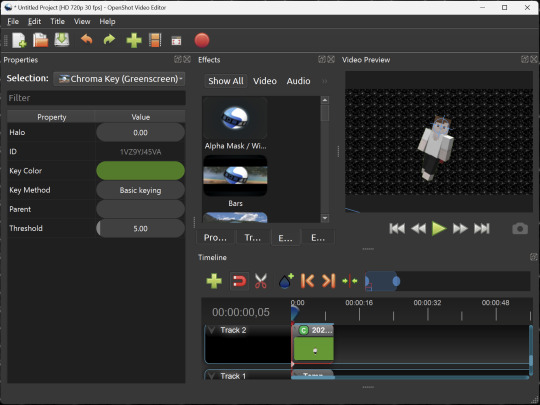
I've only made one video with it so far, but I'm already very happy with it. I had already paid for a video editor (Cyberlink PowerDirector Pro), but I needed to reinstall it and I didn't remember how. Out of desperation, I searched up "FOSS video editor" and I'm so glad I did. There's no launcher, there's no promotion of other apps and asset packs—it's just a video editor with a normal installer.
GIMP
GNU Image Manipulation Program is an image editor, much like Photoshop. Originally created for Linux but also available for Windows and MacOS, it provides plenty of functionality for editing images. It is a bit unintuitive to learn at first, though.

I've used it to create and modify images for years, including logos, really bad traceover art, and Minecraft textures. It doesn't have certain advanced tech like AI paint-in, but it has served my purposes well and it might just work for yours!
(Be sure to go to Windows > Dockable Dialogs > Colors. I have no idea why that's not enabled by default.)
Audacity
Audacity is an audio editing program. It can record, load, splice, and layer audio files and apply effects to them.
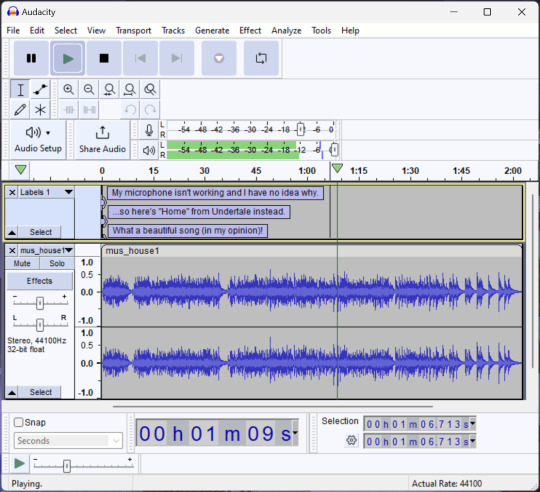
Audacity is another program I've used for a long time. It is not designed to compose music, but it is great for podcasts, simple edits, and loading legacy MS Paint to hear cool noises.
7-Zip
7-Zip is a file manager and archive tool. It supports many archive types including ZIP, RAR, TAR, and its own format, 7Z. It can view and modify the contents of archives, encrypt and decrypt archives, and all that good stuff.

Personally, I use 7-Zip to look inside JAR files for Minecraft reasons. I must admit that its UI is ugly.
Firefox
Firefox is an internet browser, much like Google Chrome, Microsoft Edge, or Safari. While browsers are free, many of them include tracking or other anti-consumer practices. For example, Google plans to release an update to Chromium (the base that most browsers are built from these days) that makes ad blockers less effective by removing the APIs they currently rely on.
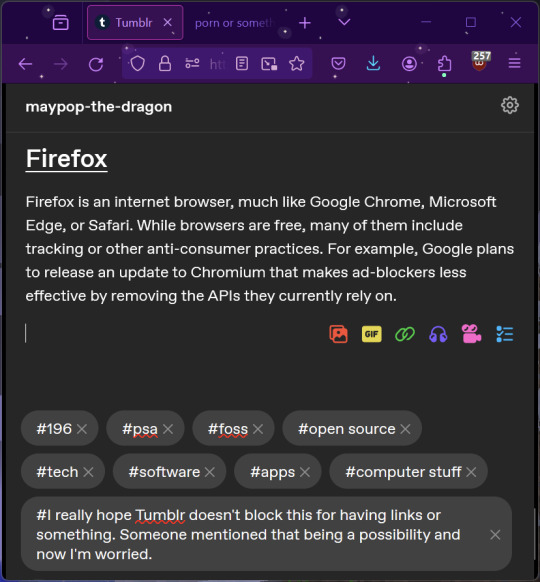
Aside from fighting monopolies, benefits include: support for animated themes (the one in the picture is Purple Night Theme), good ad blockers forever, an (albeit hidden) compact UI option (available on about:config), and a cute fox icon.
uBlock Origin
As far as I know, uBlock Origin is one of the best ad blockers there is.
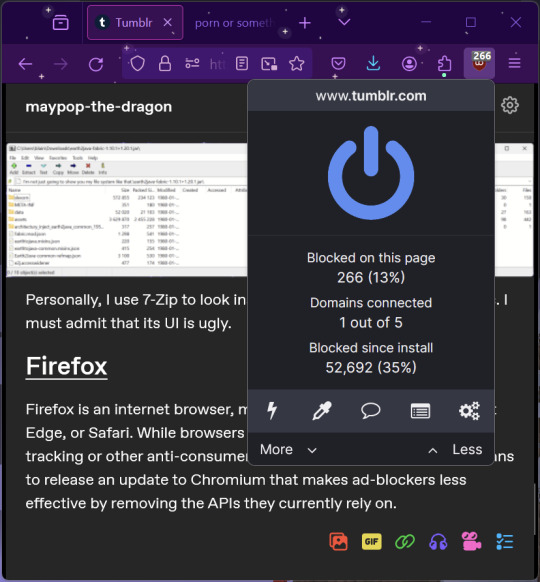
I was on a sketchy website with my brother, and he was using Opera GX's ad blocker. Much of the time when he clicked on anything, it would take us to a random sponsored page. I suggested that he try uBlock Origin, and with uBlock Origin, that didn't happen anymore.
Linux
Linux is a kernel, but the term is often used to refer to operating systems (much like Windows or MacOS) built on it. There are many different Linux-based operating systems (or "distros") to choose from, but apps made for Linux usually work on most popular distros. You can also use many normally Windows-only apps on Linux through compatibility layers like WINE.


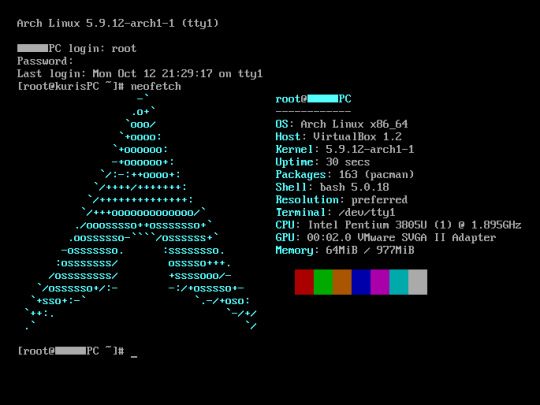
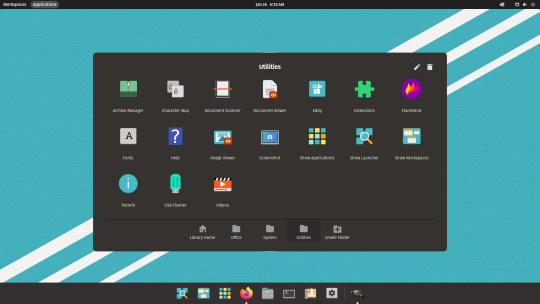
I don't have all four of these, so the images are from Wikipedia. I tried to show a variety of Linux distros made for different kinds of users.
If you want to replace your operating system, I recommend being very careful because you can end up breaking things. Many computer manufacturers don't care about supporting Linux, meaning that things may not work (Nvidia graphic cards notoriously have issues on Linux, for example).
Personally, I tried installing Pop!_OS on a laptop, and the sound output mysteriously doesn't work. I may try switching to Arch Linux, since it is extremely customizable and I might be able to experiment until I find a configuration where the audio works.
Many Linux distros offer "Live USB" functionality, which works as both a demo and an installer. You should thoroughly test your distro on a Live USB session before you actually install it to be absolutely sure that everything works. Even if it seems fine, you should probably look into dual-booting with your existing operating system, just in case you need it for some reason.
Happy computering!
#196#psa#foss#open source#tech#software#apps#computer stuff#I really hope Tumblr doesn't block this for having links or something. Someone mentioned that being a possibility and now I'm worried.#please reblog#2024-01-26
48 notes
·
View notes
Text
Entry-Level Certifications to Kickstart Your Career
Entering the job market without much experience can be challenging, but there is a way to stand out — by earning certifications that demonstrate your skills and knowledge. Certifications are especially beneficial for freshers because they offer a quick way to build credibility and gain essential skills that employers value. Whether you’re aiming for a career in IT, marketing, or healthcare, entry-level certifications can help you get your foot in the door and kickstart your career.
In this article, we will explore certifications ideal for those with little to no experience, affordable and beginner-friendly options, and how to effectively use these certifications on resume.
What Certifications Are Ideal for Freshers and Those With No Experience?
When starting your career, it’s important to choose certifications that are recognized and valued by employers, yet accessible enough for someone without prior experience. Here are some entry-level certifications across various industries that can help you kickstart your career:
1. Information Technology (IT)
CompTIA IT Fundamentals (ITF+)
Ideal for beginners, this certification covers basic IT knowledge such as network security, software development, and data management. It’s a great starting point if you’re looking to build a career in IT without prior technical experience.
Google IT Support Professional Certificate
Developed by Google, this certification is designed for those looking to enter the IT support field. It covers fundamental IT concepts and troubleshooting techniques, making it an excellent choice for freshers.
2. Marketing
Google Analytics for Beginners
This free certification from Google provides foundational knowledge in using Google Analytics to track website traffic and understand audience behavior. It’s a great starting point for those interested in digital marketing.
HubSpot Inbound Marketing Certification
This certification teaches you the basics of inbound marketing, including content creation, social media promotion, and lead nurturing. It’s ideal for freshers looking to enter the world of digital marketing and start building their online presence.
3. Healthcare
Certified Nursing Assistant (CNA)
For those interested in a healthcare career, becoming a CNA is one of the fastest and most accessible ways to enter the field. This certification prepares you to assist patients with daily tasks under the supervision of a licensed nurse.
Basic Life Support (BLS) Certification
BLS certification is essential for healthcare professionals, especially for those working in emergency care settings. It teaches the fundamentals of CPR and emergency response, making it valuable for anyone starting a healthcare career.
4. Project Management
Certified Associate in Project Management (CAPM)
This entry-level certification from the Project Management Institute (PMI) is ideal for freshers who want to build a career in project management. It provides foundational knowledge of project management concepts, tools, and techniques.
Google Project Management: Professional Certificate
This certification is designed to prepare you for a career in project management, even without prior experience. It covers the fundamentals of managing projects and teams, making it a great option for those interested in leadership roles.
These certifications are accessible for freshers, providing a solid foundation of knowledge that can be leveraged to build a successful career.
Affordable and Beginner-Friendly Certifications
For those just starting out, affordability is often a key consideration. Luckily, many beginner-friendly certifications won’t break the bank but still provide significant value. Here are some affordable options:
1. Google Analytics for Beginners (Free)
This free certification is an excellent starting point for anyone interested in learning about digital analytics. It provides practical skills in using Google Analytics to track and analyze website traffic.
2. HubSpot Inbound Marketing Certification (Free)
HubSpot offers a range of free certifications, including inbound marketing, that are valuable for freshers looking to start a career in marketing. The courses are beginner-friendly and can be completed at your own pace.
3. LinkedIn Learning Certifications (Varies)
LinkedIn Learning offers various certifications in fields such as marketing, IT, and business. With a subscription fee, you can access a wide range of beginner-level courses and earn certificates to display on your LinkedIn profile.
4. CompTIA IT Fundamentals (ITF+) ($126)
This certification provides a broad understanding of essential IT concepts and is relatively affordable compared to more advanced certifications. It’s a great choice for freshers interested in breaking into the IT field.
5. Google IT Support Professional Certificate (Free with Financial Aid, $39/month without)
This program, offered through Coursera, provides a comprehensive introduction to IT support. It’s accessible to beginners, and financial aid is available to make it even more affordable.
These certifications are not only budget-friendly but also designed to be beginner-friendly, making them excellent options for anyone looking to gain essential skills without a large financial investment.
How to Leverage Entry-Level Certifications on Your Resume?
Earning a certification is just the first step; leveraging it effectively on your resume is equally important. Here are some tips for showcasing your entry-level certifications:
1. Create a Dedicated “Certifications” Section
Place your certifications in a dedicated section on your resume, typically after your education and work experience sections. This makes it easy for employers to spot your qualifications at a glance.
2. Highlight Certifications in Your Resume Summary
Mention your most relevant certifications in your resume summary or objective statement. For example, “Recent graduate with a Google IT Support Professional Certificate, seeking an entry-level IT support role.”
3. Pair Certifications with Relevant Skills
If your certification has taught you specific skills (e.g., troubleshooting for IT support or lead generation for marketing), include these skills in your “Skills” section and indicate how they were developed through your certification.
4. Tailor Certifications to the Job Description
Ensure that the certifications you feature are relevant to the job you’re applying for. For example, if the job requires project management skills, highlight your CAPM or Google Project Management certification.
5. Include Completion Date
Including the date you earned your certification demonstrates that your skills are up-to-date. For certifications that require renewal, this also shows that you’re actively maintaining your qualifications.
By strategically placing and highlighting your certifications, you can show employers that, even without much experience, you possess the skills and knowledge necessary to excel in the role.
Conclusion
For freshers entering the job market, certifications are a powerful way to gain credibility and improve your chances of landing a job. From IT and healthcare to marketing and project management, numerous affordable, beginner-friendly certifications can kickstart your career. By earning certifications and effectively leveraging them on your resume, you demonstrate to employers that you’re proactive, knowledgeable, and ready to contribute.
For more guidance on how to include certifications on your resume, check out our complete guide here: Certifications on Resume.
#resume#resume tips#resume writing services online#resume writing tips#resume adjectives#resume buzzwords
9 notes
·
View notes
Text
🎮 The Ultimate Guide to Game Development: How, Why, and What You Need to Know
Game development is more than just coding—it’s art, storytelling, strategy, and technology all rolled into one. In 2025, with games dominating mobile, PC, VR, and console platforms, learning how games are made and why they matter has never been more important.
Whether you're a beginner, a business, or just curious, this guide will help you understand the what, why, and how of modern game development.
🎯 What Is Game Development?
Game development is the process of creating a video game. It includes:
Designing the game world
Programming mechanics
Creating visuals, sounds, and storylines
Testing and releasing the final product
Game development combines coding, art, animation, game design, and project management.
💡 Why Game Development Matters in 2025
Here’s why game development is booming right now:
1. Huge Market Growth
The global game industry is expected to cross $250 billion in 2025.
Mobile games lead, but PC, console, and VR are also growing.
2. Job Opportunities
Game developers, designers, 3D artists, animators, and testers are in high demand.
Indie game studios are thriving thanks to platforms like Steam, Epic Games Store, and Google Play.

3. Powerful Tools Are Free or Low-Cost
Engines like Unity, Unreal Engine, and Godot let anyone build a game.
Assets, code samples, and tutorials are more accessible than ever.
🔨 The Game Development Process (Step-by-Step)
1. Concept & Planning
Start with an idea. What’s your game about? What’s the genre? Is it single-player or multiplayer?
2. Game Design
This includes:
Game mechanics
Levels or missions
User interface (UI)
Story and character development
3. Development (Coding)
Programmers bring the design to life using game engines. Common languages include:
C# (Unity)
C++ (Unreal Engine)
GDScript (Godot)
4. Art & Sound
Artists create characters, environments, UI elements, and animations. Sound designers add music, effects, and voiceovers.
5. Testing & Debugging
QA testers find and fix bugs. This step is crucial to create a smooth experience.
6. Launch & Updates
Once the game is stable, it’s launched on platforms like:
Steam for PC
Google Play / App Store for mobile
Xbox / PlayStation for consoles
Ongoing updates keep players engaged.
🛠️ Tools & Technologies You Should Know
Tool/PlatformPurposeUnity2D/3D Game Engine (Cross-platform)Unreal EngineHigh-end 3D graphics (AAA games, VR/AR)Blender3D modeling and animationPhotoshop2D game assetsGit & GitHubVersion control for teams
🚀 How to Start Game Development (Even as a Beginner)
Choose a game engine: Unity is great for beginners.
Follow tutorials: YouTube, Coursera, Udemy, and free docs are helpful.
Make a small game: Try a simple 2D puzzle or runner.
Join a community: Reddit, Discord, and game dev forums are great for feedback.
Keep learning: Don’t rush. Every new project builds your skills.
🧠 Common Game Genres to Explore
Action & Adventure
Puzzle & Strategy
Role-Playing Games (RPG)
Simulation (e.g., farming, life, racing)
Multiplayer Online Games
VR & AR experiences
🎯 Final Thoughts
Game development in 2025 is more accessible and exciting than ever. You don’t need a huge budget to get started—you need passion, creativity, and consistency.
Whether you want to make indie games, join a game studio, or bring your brand into gaming, now is the time to start.
🔗 Want to turn your game idea into reality? We3Vision Pvt Ltd offers complete game development services—from concept to launch—tailored to your vision.
2 notes
·
View notes
Text
Free Tools Every Beginner Needs to Start Digital Marketing

Starting your journey in digital marketing? You don’t need to spend thousands to get going. With the right free tools and a bit of guidance, anyone can start building campaigns, analyzing results, and growing their online presence.
In fact, enrolling in the best digital marketing course can help you learn how to use these tools effectively. If you're looking for expert-led, practical training, the best digital marketing course in Hyderabad is a great place to start!
Let’s explore the top free tools every beginner should know.
Google Keyword Planner
One of the most recommended tools taught in every top digital marketing course, Google Keyword Planner helps beginners:
Find the right keywords
Understand search volume
Analyze keyword competition
This tool is often the starting point for anyone creating SEO or Google Ads strategies.
Google Analytics
Every digital marketer needs to track how users interact with their website. Google Analytics is a must-have tool to:
Monitor website traffic
Understand user behavior
Identify top-performing pages
The best digital marketing courses in Hyderabad include hands-on sessions on using Google Analytics to drive better results.
Google Search Console
This tool helps you:
Check how your site performs in Google Search
Fix indexing issues
Track keyword impressions and clicks
It’s covered in depth in the best digital marketing courses, especially in SEO and performance marketing modules.
Canva
Not a designer? No problem! Canva is a drag-and-drop tool for creating:
Social media graphics
Posters and presentations
YouTube thumbnails and more
Most instructors from the best digital marketing course in Hyderabad recommend Canva to beginners for quick and professional design.
Mailchimp (Free Plan)
Email marketing is powerful, and Mailchimp helps you get started for free:
Send automated emails
Build subscriber lists
Design email templates easily
Used widely in real-world projects, this tool is commonly included in digital marketing course curriculums.
Meta Business Suite
Running Facebook and Instagram campaigns? Meta Business Suite lets you:
Schedule and publish posts
Manage messages
Track ad performance
It’s one of the essential tools introduced in any best digital marketing course with a focus on social media marketing.
Ubersuggest
Created by marketing expert Neil Patel, this SEO tool helps with:
Keyword ideas
Competitor research
Site audits
Beginners love it for its simplicity — and it’s often mentioned in digital marketing training sessions.
Bitly
Bitly shortens long URLs and tracks how many clicks you get — simple but powerful for social media marketers. Many trainers from the best digital marketing course in Hyderabad recommend it for campaign tracking.
Conclusion:
Digital marketing doesn't have to be expensive when you're just starting out. With free tools like Google Keyword Planner, Canva, and Google Analytics, you can begin learning and applying marketing strategies right away.
But tools alone aren't enough. Learning how to use them the right way matters. That’s why enrolling in the best digital marketing course — especially if you're in a city like Hyderabad — can give you a huge edge. The best digital marketing course in Hyderabad blends hands-on training, real-time projects, and expert guidance to make you job-ready.
#best digital marketing course#best digital marketing course in Hyderabad#OnlineMarketing#digital marketing course curriculums.#MarketingTips#SEO
2 notes
·
View notes